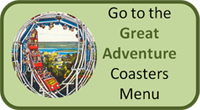
During the 1980's coaster manufacturers were striving to develop new
types of coasters and coaster elements to satisfy the world's theme
parks demand for newer, bigger, better coasters. One idea which was
pursued by several companies was the heart-line spiral which turned the
riders upside down while traveling in a straight line rather than
through a loop or corkscrew. While several manufacturers worked on this
design, only the Togo Corporation of Japan went beyond the prototype
stage.
|
|
|
|
|
 |
|
|
|
|
 |
Ultra Twister was a new twist in coaster design, never seen before in
the U.S. and really unique in many ways.
The site in the park
chosen for Ultra Twister was a previously undeveloped area of woods
between Rolling Thunder and Lahaway Creek alongside the Fort. As part of the
development, a new path behind the Fort was created and a bridge was built
over the creek to connect the two sides, improving traffic flow by
joining the formerly separate Best of the West and Hernando's
Hideaway sections. |
 |
|
|
|
 |
 |
 |
|
|
|
|
 |
Ultra Twister's unique coaster design was first constructed in model
format during the days before computer animation. There were several models of the ride,
including a working model which stood about 5 feet high. The models were
never displayed in the park, but years later were sold in a park auction
of excess equipment.
Construction of the ride began in November
of 1985, and the ride finally opened to the public on June 6, 1986.
Guests watched as the pieces came together during April and May, anxiously
awaiting the ride's opening.
The coaster's
first of their kind elements including a vertical lift in which cars
backed into a pivoting track section which rotated skyward, leaving the
passengers laying on their backs as the lift engaged and carried them up
the 100 foot tower. |
 |
|
|
|
 |
 |
|
|
|
|
 |
 |
|
|
 |
|
|
|
|
 |
Once at the top, the car crept into the 90 degree first drop, plunging
to the roof of the boarding area below then pulling into a hill.
The ride's speed was enhanced by the rings surrounding the tracks. The
rings were necessary for the spiral sections of the ride, but were
installed for the length of the track to heighten the feeling of speed
and create the unique look of the ride.
After sailing over the
hill, the cars leveled out and came to the first of the heart line
spirals, then up a small hill into a set of brakes. The brakes brought
the car to a stop on a piece of track with an emergency run out dead
ending high above the walkway in case the brakes failed.
|
 |
|
|
|
 |
 |
|
|
|
|
 |
 |
 |
|
|
 |
|
|
|
|
Click the placard below to watch the original
Ultra Twister commercial.
 |
 |
|
|
|
|
|
|
|
|
 |
 |
 |
|
|
Once the car had stopped at the end of the
top section of track, the track would then tilt, releasing the car
backwards into the lower track section where it did two more heartline
spirals before hitting the brakes and coming into the station.
Even the station was unique, with a
moving walkway for loading and unloading guests which matched the speed
of the cars as they constantly advanced and moved through to the lift.
The unique system of rails which ran at
rider's shoulder level throughout the ride to make the heartline rolls
possible meant the open cars had to be fitted with guards to protect
guests as the rails were very close. The rails ended on one side as the
cars entered the station, with loading and unloading on one side, while
the rail continued on the opposite side. This was necessary to
keep the wheels properly aligned on the one end of the car which were
designed to move and flex.
|
|
 |
 |
|
|
|
 |
 |
 |
|
|
|
|
|
(Above images photographed by Ric Turner and Erik Sakowski and can be viewed on
RCDB.com.) |
|
|
|
|
|
|
|
|
 |
 |
 |
|
|
|
|
 |
One of the more unique attributes of Ultra Twister was its
relatively small footprint. The structure was a single straight line
which was placed parallel to Rolling Thunder's lift hill. The stacked
track configuration meant the rides rack length was double that of its
overall structure length.
|
 |
|
|
|
|
 |
 |
 |
|
|
|
|
 |
While Ultra Twister was a unique and exciting ride, it had several flaws
including a proclivity to developing stress fractures which required
constant re-welding. Also, the vertical lift was difficult and dangerous
when guests had to be evacuated, with a small elevator which meant only
one guest could be removed at a time. Guests had to roll out of their
seats, then cross a gap between the vehicle and the elevator up to 100
above the ground. The riskiness of this maneuver was driven home as executives from Wesray,
the company which had just purchased Six Flags got stuck on the ride's
lift while touring the park and had to be evacuated.
|
 |
|
|
 |
|
|
|
|
 |
 |
 |
|
|
|
|
 |
 |
 |
|
|
|
|
 |
 |
 |
|
|
|
|
 |
The problems of Ultra Twister kept compounding and after a
spotty record of running, the coaster was closed during
the latter months of the 1988 season. Given the riskiness of the
ride's complex evacuation procedure, management debated if the ride
would return the following year with a modified lift that would
extend the lift angle from vertical to a
less extreme 45 degrees. However, these modifications would not
occur at Great Adveture.
|
 |
|
|
|
|
 |
 |
 |
|
|
|
|
 |
Technical Information
|
Manufacturer: |
Togo Japan
Inc. |
| Ride
Model: |
Ultra Twister |
| |
|
| Track
Length: |
1181 Feet |
| Maximum
Height: |
96.8 Feet |
| |
|
| Lift
Track: |
90 degrees - straight up |
| Maximum
Drop: |
85 degrees |
| |
|
| Maximum
Speed: |
43.5 mph |
| |
|
| Number
of Cars: |
8 |
|
Passengers per Car: |
6 |
| Cycle
Capacity: |
48 |
| |
|
| Riding
Time: |
1 Minute 40 Seconds |
|
Loading/Unloading Time: |
30 Seconds |
| Hourly
Capacity: |
1080 riders per hour |
| |
|
|
Restraining Device: |
Shoulder Harness |
|
Loading/Unloading Dock: |
Via Conveyer Belt |
| Upper
Track: |
Forward run with (1) spin rotation. |
| Lower
Track: |
Backward run with (2) spin rotations. |
|
|
|
|
|
 |
 |
 |
|
|
|
|
 |
 |
 |
|
|
|
|
 |
 |
 |
|
|
|
|
 |
 |
 |
|
|
|
|
 |
 |
 |
|
|
|
|
 |
 |
 |
|
|
|
|
 |
 |
 |
|
|
|
|
 |
 |
 |
|
|
|
|
 |
 |
 |
|
|
|
|
 |
During the 1989 season the ride was closed and carefully
disassembled as it became part of Six Flags "Ride Rotation Program".
Just as in 1986 when guests got to watch the ride being built, visitors also
got to see it taken apart over several weeks.
The "Ride Rotation Program" moved coasters and other rides from
park to park in an effort to save money and constantly introduce "new"
rides to every park every season. For many of these rides rotation was
scheduled once the
novelty wore off and the ridership dropped off resulting with a removal
that was a
minimal hardship.
The worst limitation of Ultra Twister was
its limited capacity which meant it wasn't a good fit for Great
Adventure. A smaller park would be a much better fit, and Six Flags
Astroworld was selected. Being the smallest of the Six Flags
properties space was limited, so a ride with a small footprint like
Ultra Twister worked well. |
 |
|
|
|
 |
 |
|
|
|
 |
 |
|
|
|
|
 |
 |
 |
|
|
|
|
 |
 |
 |
|
|
|
|
 |
 |
 |
|
|
|
|
 |
Once Ultra Twister had been removed, its site sat vacant with a chain
link fence around the concrete footers, a small white shed, and the
ride's former control room still standing on the red gravel.
Plans for redeveloping the plot of land came and went several times. At
one point half of Lightnin' Loops was going to be relocated there, which
would have logically put "Lightnin' Loop" alongside Rolling Thunder. |
 |
|
|
|
 |
 |
|
|
|
|
 |
 |
 |
|
|
|
|
 |
For the 1995 season Ultra Twister's former site was finally redeveloped
with another one of a kind Togo built coaster taking its place. The shed
and ride control room were reused for Viper, getting a rustic appearance
to match Viper's ghost town facade and desert scenery.
Viper's
performance proved to be as bad as Ultra Twister's and in 2005 it was
removed to make way for El Toro which operates there today.
|
 |
|
|
 |
|
|
|
|
|
|
|
|
 |
 |
 |
|
|
|
|
 |
 |
 |
|
|
|
|
|
|
|
|
|
|
|
|
|
Click the placard below to view a news special about the Ultra Twister. |
|
|
|
 |
 |
|
|
|
|
When Ultra Twister was relocated to
Six Flags AstroWorld, the coaster
was
modified removing the vertical lift
and replacing it with a more
traditional 45 degree lift hill.
The coaster continued to delight
guests
from 1990 until the park
closed in October 2005.
(Images below photographed as noted. Photos can be found on RCDB.com.) |
|
|
|
|
 |
 |
 |
|
|
 |
|
|
|
|
|
|
|
|
 |
When AstroWorld
closed, Ultra Twister was once again dissembled and prepared to move to
another park, this time to Six Flags America.
Unfortunately the ride was
damaged when it was disassembled, and with the manufacturer being out of business
and its advanced age meant that repairs were more costly than the value of the
ride.
In 2010 the ride was put up for sale on ITAL, a used ride broker, ending
the chances that the Ultra Twister would ever reopen at a Six Flags
park. |
 |
|
|
 |
|
|
|
|
|
|
|
|
 |
Souvenirs featuring
the Ultra Twister at
Six Flags Great Adventure: |
 |
|
|
|
|
 |
 |
 |
|
|
|
|
|
|



